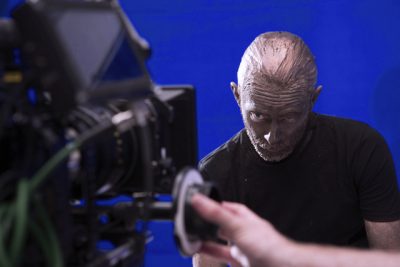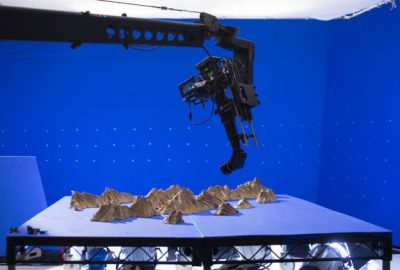Atoms for Peace’s new promo for their song Before Your Very Eyes features lead singer Thom Yorke (of Radiohead) engulfed in liquified mountain ranges, crumbling cities and a psychedelic cave system. Informed by an elaborate live action shoot, visuals for the promo – which was directed by Andrew Thomas Huang for Colonel Blimp – were then created by BlinkInk. We talk to Huang about how the work was done.
fxg: The video seems like such a great combination of practical and digital craftwork – what was BlinkInk’s brief for the project?
Andrew Thomas Huang: Coming away from shooting in Los Angeles having shot Thom in heavy makeup as well as miniature sets of mountainscapes, Blinkink’s challenge was to literally fill in the gaps between Thom and the miniatures with a rippling CG topographic landscape for all 70 shots, as well as rising and crumbling city and a cave full of thousands of dancing stalactites – all on a shoestring budget.

fxg: What was the process for modeling Yorke’s face – did this come from the main camera or from extra reference photography or scanning?
Huang: We used a combination of photogrammetry and carefully modeling by hand against a ton of reference of footage. We took 360 photos of Thom’s head on set and triangulated those images to form a rough photogrammetry head, then our modeler Lucas Cuenca went in and re-topologized the head and body in ZBrush.
fxg: What were some of the challenges of tracking and re-creating his face and adding breakages etc to it, especially with the stop motion look?
Huang: A huge bulk of our work involved carefully matchmoving Thom’s face and hands, down to his subtle finger movements. We also shot Thom at 12 frames per second and slowed down his song on set so that during playback he had all sorts of strange twitches and stop motion irregularities to his movement. This added with the many facial tracking, landscape tracking and distorted wide lenses, the matchmove for this job was a feat in and of itself.
fxg: Can you describe developing the look of the shifting sands? What were some of the tools you used to do this? Any custom applications?
Huang: R James Healy (visual effects supervisor) was the genius behind scripting the landscape. I worked closely with him first through a ton of sketches, trying to figure out the physics of something physically impossible that can only be created in CG, but that also had to have the movement of hand-crafted stop-motion. After doing many sketches of dripping, radiating rings and dialing the look we were after, James worked tirelessly in MEL script to develop modular systems in Maya using a combination of lattices, wrap deformers and curves to create a rippling movement that could be controlled. James also scripted a large framework of tools for all of our TDs and animators to use throughout the 4 month job. This scripting alone and disseminating these tools was one of the biggest challenges of the video.

fxg: How were the mountainous and cave environments constructed – can you talk about taking what was shot in miniature and bluescreen and adding to that?
Huang: Production Designer Rebecca Stillman, who has a longstanding collaboration with Henry Selick, and her art director Adrian Romo built many of the miniatures in Los Angeles with the help of Screen Novelties. We sculpted the mountains out of styrofoam and the buildings were made out of foam and wood. We made doubles of all the buildings out of a glass-sand-like mold which were designed to crumble. All the miniatures were shot on bluescreen with the RED Epic on a jib which roamed around the tabletop set to give that sense of aerial plane shots drifting across the landscape.
